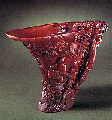 Generally speaking "tooth and horn carving" refers to objects carved out of animal teeth and horns, and in the circle of collectors, it refers specifically to works carved out of ivory and rhinoceros horns. Ivory is naturally beautiful, white and soft, and is therefore very exquisite and full of artistic charm; Rhinoceros horn carving is famous for its rarity and great value.
Generally speaking "tooth and horn carving" refers to objects carved out of animal teeth and horns, and in the circle of collectors, it refers specifically to works carved out of ivory and rhinoceros horns. Ivory is naturally beautiful, white and soft, and is therefore very exquisite and full of artistic charm; Rhinoceros horn carving is famous for its rarity and great value.
 Origin and development
Origin and development
Ivory carving is one of China's oldest arts and examples of skillfully carved ivory have been found in tombs as far back as theShang Dynasty(18th -12th century BC) kings; these pieces are so well designed and executed that they suggest a long previous development, probably going back toprehistoric times. Dozens of ivory carvings were excavated from a site ofHemuduCulture about 7,000 years ago.
pieces are so well designed and executed that they suggest a long previous development, probably going back toprehistoric times. Dozens of ivory carvings were excavated from a site ofHemuduCulture about 7,000 years ago.
During the Shang and Zhou dynasties,tooth carvinggradually became prosperous. By the Tang (618-907) and Song (960-1279) dynasties, tooth and horn carving was much more sophisticated in terms of both technique and craftsmanship. In theMing Dynasty(1368-1644), the carving became very popular, while the carving style tended to be simple and smooth.
 In theQing Dynasty(1644-1911), due to the emergence and development of capitalism, the handicraft industry and businesses began to prosper, and western culture was gradually introduced into China. People's cultural and aesthetic consciousness was gradually enhanced and the tastes of the royal court and feudal officials increased demand for tooth and horn carvings, triggering the unprecedented development of the handicraft during the period. As a result, many skillful craftsmen emerged, producing a large number of beautiful tooth and horn carving works. However, due to the shortage of raw materials, rhinoceros horn carving only enjoyed a short period of prosperity during the reigns of EmperorsYongzhengandQianlong.
In theQing Dynasty(1644-1911), due to the emergence and development of capitalism, the handicraft industry and businesses began to prosper, and western culture was gradually introduced into China. People's cultural and aesthetic consciousness was gradually enhanced and the tastes of the royal court and feudal officials increased demand for tooth and horn carvings, triggering the unprecedented development of the handicraft during the period. As a result, many skillful craftsmen emerged, producing a large number of beautiful tooth and horn carving works. However, due to the shortage of raw materials, rhinoceros horn carving only enjoyed a short period of prosperity during the reigns of EmperorsYongzhengandQianlong.
During modern times, the world has run into a more serious shortage of tooth and horn resources. With increased awareness of the impact ivory trade has on endangered species, the protection of wild animals has developed and many countries, including China, have forbidden the auction of tooth and horn carvings. This means that the carving will become more valuable articles for collection, enjoying a great potential for appreciation.
